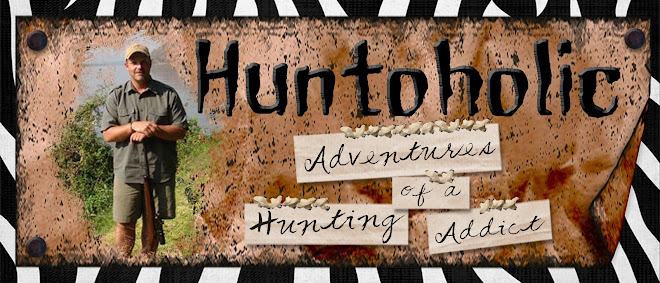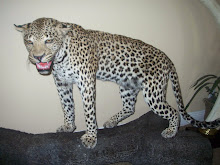 The African "Big Five" of dangerous game trophies refers to the five trophies hunted for centuries by African hunters, and feared by natives and white hunters alike. The big five is comprised of cape buffalo (known to the Shona and Ndebele as "nyati"), leopard, lion, rhino (specifically black rhino) and elephant. In addition, some would also include crocodile and hippo, and then refer to the group as the "magnificent seven."
The African "Big Five" of dangerous game trophies refers to the five trophies hunted for centuries by African hunters, and feared by natives and white hunters alike. The big five is comprised of cape buffalo (known to the Shona and Ndebele as "nyati"), leopard, lion, rhino (specifically black rhino) and elephant. In addition, some would also include crocodile and hippo, and then refer to the group as the "magnificent seven." Regardless of how one characterizes the dangerous game of Africa, there is hardly a hunter who ever steps foot on the continent who doesn't shortly begin dreaming of pursuing this penultimate group of African big game species. I've been fortunate enough to take three of the five, or five of the seven, depending on how inclusive one wishes to be (in this I include the cow elephant shot, really is self defense, while hunting bull elephant). I have yet to take a lion, which for financial reasons may never happen; and rhino will assuredly never happen. The black rhino has been only recently brought back from the brink of extinction (the victim of uncontrolled poaching for bushmeat and horn), and the white rhino - larger and more docile, is only hunted in South Africa and Namibia and still quite expensive.
In 2006 I began my dangerous game career in the central Zimbabwe area of Gokwe North. I was there to hunt buffalo, leopard and elephant. Gokwe is a CAMPFIRE or communal area as opposed to a national parks area. In CAMPFIRE areas game is owned and managed, with oversight from National Parks, by the individual communities or tribes of native Zimbabweans. Quotas are set by National Parks for the communities, but the individual communities assign and sell the concession rights to outfitters who successfully bid and also decide how the quotas are taken.
 Gokwe North is not known as the greatest buffalo area, but there are plenty of buffalo and good trophies are relatively common. We were not concerned about finding buffalo, and so we concentrated on elephant and leopard as primary targets. Despite that focus, over the first week of the hunt we frequently cut buffalo tracks while checking leopard baits or looking for elephant tracks. When we would cut buffalo tracks we'd follow them relentlessly. The day before we shot this bull we followed and continually buggered a herd of at least 50 buffalo over the course of about 10 miles of tracking, but were never able to get a bead on a good bull in the herd. Several times after the guys had spotted a feeding herd of buffalo from the cruiser we went on one of Kirk's signature "Zambezi death marches."
Gokwe North is not known as the greatest buffalo area, but there are plenty of buffalo and good trophies are relatively common. We were not concerned about finding buffalo, and so we concentrated on elephant and leopard as primary targets. Despite that focus, over the first week of the hunt we frequently cut buffalo tracks while checking leopard baits or looking for elephant tracks. When we would cut buffalo tracks we'd follow them relentlessly. The day before we shot this bull we followed and continually buggered a herd of at least 50 buffalo over the course of about 10 miles of tracking, but were never able to get a bead on a good bull in the herd. Several times after the guys had spotted a feeding herd of buffalo from the cruiser we went on one of Kirk's signature "Zambezi death marches." When we weren't on the "death march," Kirk was particularly fond of a of a rocky outlook on the point of a long narrow plateau above camp. They had named it  "buffalo rock," because of its propensity to produce sightings of buffalo herds in the low flood plains on the hank of the Ume River. We would take the cruiser to the base of the hill and hike to the top and watch the lowlands for various game. In about 5 trips to Buffalo Rock, we spotted kudu, warthog, elephant, impala, waterbuck, baboon, bushbuck and listened to a very interesting scape between a lion and baboon troop in the thick brush at the base of a nearby kopke.
"buffalo rock," because of its propensity to produce sightings of buffalo herds in the low flood plains on the hank of the Ume River. We would take the cruiser to the base of the hill and hike to the top and watch the lowlands for various game. In about 5 trips to Buffalo Rock, we spotted kudu, warthog, elephant, impala, waterbuck, baboon, bushbuck and listened to a very interesting scape between a lion and baboon troop in the thick brush at the base of a nearby kopke.
 "buffalo rock," because of its propensity to produce sightings of buffalo herds in the low flood plains on the hank of the Ume River. We would take the cruiser to the base of the hill and hike to the top and watch the lowlands for various game. In about 5 trips to Buffalo Rock, we spotted kudu, warthog, elephant, impala, waterbuck, baboon, bushbuck and listened to a very interesting scape between a lion and baboon troop in the thick brush at the base of a nearby kopke.
"buffalo rock," because of its propensity to produce sightings of buffalo herds in the low flood plains on the hank of the Ume River. We would take the cruiser to the base of the hill and hike to the top and watch the lowlands for various game. In about 5 trips to Buffalo Rock, we spotted kudu, warthog, elephant, impala, waterbuck, baboon, bushbuck and listened to a very interesting scape between a lion and baboon troop in the thick brush at the base of a nearby kopke. This buffalo was shot quite by accident as we were driving to Buffalo Rock for a pilgrimage to the top, and the guys spotted a herd of buffalo moving through the thick cover about 500 yards from the cruiser. We were able to jump out and sneak to a position of ambush ahead of the herd.  There were intermittent openings in the thick cover that allowed us look the herd over in pieces as they moved toward us. I was on the shooting sticks and waited as a lead cow appeared from an opening and then this bull stepped into the opening and turned his head to stare us down with that "you owe me money look." The hook of his left horn drooped down in front of his left shoulder, and Kirk kept warning me, "don't hit him in the horn."
There were intermittent openings in the thick cover that allowed us look the herd over in pieces as they moved toward us. I was on the shooting sticks and waited as a lead cow appeared from an opening and then this bull stepped into the opening and turned his head to stare us down with that "you owe me money look." The hook of his left horn drooped down in front of his left shoulder, and Kirk kept warning me, "don't hit him in the horn."
 There were intermittent openings in the thick cover that allowed us look the herd over in pieces as they moved toward us. I was on the shooting sticks and waited as a lead cow appeared from an opening and then this bull stepped into the opening and turned his head to stare us down with that "you owe me money look." The hook of his left horn drooped down in front of his left shoulder, and Kirk kept warning me, "don't hit him in the horn."
There were intermittent openings in the thick cover that allowed us look the herd over in pieces as they moved toward us. I was on the shooting sticks and waited as a lead cow appeared from an opening and then this bull stepped into the opening and turned his head to stare us down with that "you owe me money look." The hook of his left horn drooped down in front of his left shoulder, and Kirk kept warning me, "don't hit him in the horn."  The 500 grain Hornady soft point did the job and we heard the bull go down within 80 yards of the shot. By the time we got to him, the herd had disappeared. As we stood there admiring him, we were startled to hear "urrgg, urrgg" about 15 yards away - two young bulls from the herd had circled back to get us! Kirk and I both raised our rifles in the direction of the sound and Kirk gave me the instruction to "shoot anything that sticks its nose out of the bush." Fortunately, the problem never developed and the bulls were chased off when Moses, the game scout, emptied a load of buckshot from his 12 gauge into the brush.
The 500 grain Hornady soft point did the job and we heard the bull go down within 80 yards of the shot. By the time we got to him, the herd had disappeared. As we stood there admiring him, we were startled to hear "urrgg, urrgg" about 15 yards away - two young bulls from the herd had circled back to get us! Kirk and I both raised our rifles in the direction of the sound and Kirk gave me the instruction to "shoot anything that sticks its nose out of the bush." Fortunately, the problem never developed and the bulls were chased off when Moses, the game scout, emptied a load of buckshot from his 12 gauge into the brush. Unlike the buffalo I shot in 2008, we were able to get the cruiser right to this one to load him up.















1 comment:
Do these ugly fellas taste like Bison or Buffalo that you've hunted here in the states? Curious if they have a "wilder" flavor.
Post a Comment